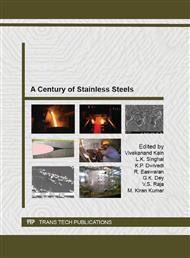p.26
p.37
p.44
p.50
p.63
p.75
p.90
p.103
p.117
Influence of Intrinsic Solidification Behaviour on Quality of Stainless Steel Cast and Rolled Products
Abstract:
Recent advances in continuous casting have facilitated remarkable improvement in the quality of cast steel. The focus of the present paper is directed towards understanding of the influence of chemistry and intrinsic solidification behaviour on the different quality issues of stainless steel. An attempt has been made, wherever possible in quantitative terms , to correlate the chemistry and the process parameters with the quality factors. The relevant theoretical background has been touched upon. Understanding has been developed on the role of the ratio of nickel equivalent and chromium equivalent. This factor can be used to represent the chemistry of any stainless steel grade. Under similar casting conditions, specific problem of mould sticking , strand bulging , or depression formation has been explained invoking this chemistry factor. Each quality issue owes its genesis to interaction between the high-temperature strength and ductility of the solidifying shell during casting. The important roles of micro-segregation , the effective shell thickness during the early stage of casting , and the temperature range of transformation for δ-ferrite to austenite have been highlighted. An approach of grade-specific casting practice has been suggested to formulate the specific casting parameters. The developed understanding has been utilised to address specific quality problems in continuously cast slabs and rolled products of different stainless steel grades. This integrated understanding can be useful for ensuring the quality of stainless steel of any chemistry.
Info:
Periodical:
Pages:
63-74
Citation:
Online since:
September 2013
Authors:
Price:
Сopyright:
© 2013 Trans Tech Publications Ltd. All Rights Reserved
Share:
Citation:


